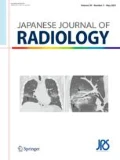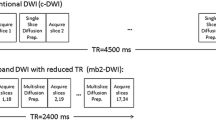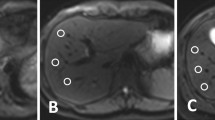Abstract
Purpose
The aim of this study was to determine the validity of the hepatic apparent diffusion coefficient (ADC) measurement. The influence of differences in measured location and administration of Buscopan (hyoscine butylbromide) for ADC were assessed.
Materials and methods
SENSE-DWI (b = 0, 500) was obtained before and after Buscopan administration to 30 patients suspected of having a liver tumor. In this sequence, respiration gating was employed, but cardiac triggering was not. ADC measurement was performed in the hepatic parenchyma of both right and left lobes in selected slices. A statistical analysis was performed to estimate the correlation among ADC, measured location, Buscopan, and pulse rate. The images were visually evaluated to categorize the subcardiac signal loss in the left lobe.
Results
The ADC showed higher values in the left lobe than in the right lobe in both pre- and postloaded studies (P < 0.001). In a comparison between ADCs in the pre- and postloaded studies, the differences were not significant in the left lobe (P = 0.93) or the right lobe (P = 0.41). No correlation was noted between ADCs and the pulse rate. Visual evaluation revealed that the subcardiac signal loss was more prominent in the postloaded study.
Conclusion
ADC measurement of the left hepatic lobe was far more incorrect than that of the right lobe if cardiac gating was not employed. The administration of Buscopan worsened the image quality of the left lobe and made visual evaluation difficult.
Similar content being viewed by others
References
K Nasu Y Kuroki S Kuroki K Murakami S Nawano N Moriyama (2004) ArticleTitleDiffusion-weighted single shot echo planar imaging of colorectal cancer using a sensitivity-encoding technique Jpn J Clin Oncol 34 620–6 Occurrence Handle15591461 Occurrence Handle10.1093/jjco/hyh108
Y Kuroki K Nasu K Kuroki K Murakami T Hayashi R Sekiguchi et al. (2004) ArticleTitleDiffusion weighted imaging of breast cancer with the apparent diffusion coefficient value Magn Reson Med Sci 3 79–85 Occurrence Handle16093623 Occurrence Handle10.2463/mrms.3.79
T Takahara Y Imai T Yamashita S Yasuda S Nasu M Van Cauteren (2004) ArticleTitleDiffusion weighted whole body imaging with background body signal suppression (DWIBS): technical improvement using free breathing, STIR and high resolution 3D display Radiat Med 22 275–82 Occurrence Handle15468951
K Nasu Y Kuroki S Nawano S Kuroki T Tsukamoto S Yamamoto et al. (2006) ArticleTitleHepatic metastases: diffusion-weighted sensitivity-encoding versus SPIO-MRI-enhanced MR imaging Radiology 239 122–30 Occurrence Handle16493012
EO Stejskal JE Tanner (1965) ArticleTitleSpin echoes in the presence of a time-dependent field gradient J Chem Phys 42 288–92 Occurrence Handle1:CAS:528:DyaF2MXisFOrtQ%3D%3D Occurrence Handle10.1063/1.1695690
EM Haake RW Brown MR Thompson R Venkatesan (1999) Random walk, relaxation and diffusion EM Haake (Eds) Magnetic resonance imaging: physical principles and sequence design Wiley New York 619–36
P Murz S Flacke F Traber JS van den Brink J Gieseke HH Schild (2002) ArticleTitleAbdomen: diffusion-weighted MR imaging with pulse-triggered single-shot sequence Radiology 224 258–64
D Xing NG Papadekin CLH Haung VM Lee TA Carpenter LD Hall (1997) ArticleTitleOptimized diffusion-weighting for measurement of apparent diffusion coefficient in human brain Magn Reson Imaging 15 771–84 Occurrence Handle9309608 Occurrence Handle1:STN:280:ByiH2MritlM%3D Occurrence Handle10.1016/S0730-725X(97)00037-4
T Ichikawa H Haradome J Hachiya T Nitatori Araki T. Diffusion-weighted (1998) ArticleTitleMR imaging with a single-shot echoplanar sequence: detection and characterization of focal hepatic lesions AJR Am J Roentgenol 170 397–402 Occurrence Handle9456953 Occurrence Handle1:STN:280:DyaK1c7hvVSluw%3D%3D
T Kim T Murakami S Takahashi M Hori K Tsuda H Nakamura (1999) ArticleTitleDiffusion-weighted single-shot echoplanar MR imaging for liver disease AJR Am J Roentgenol 173 393–8 Occurrence Handle10430143 Occurrence Handle1:STN:280:DyaK1MzlslaisA%3D%3D
ME Josephson (1993) Electrophysiologic investigation: general concept ME Josephson (Eds) Clinical cardiac electrophysiology technique and interpretation EditionNumber2nd ed Williams & Wilkins Philadelphia 22–70
P Denes D Wu R Dhingra RJ Pietras KM Rosen (1974) ArticleTitleThe effects of cycle length on cardiac refractory periods in man Circulation 49 32 Occurrence Handle4271710 Occurrence Handle1:STN:280:CSuD2MnosVI%3D
Author information
Authors and Affiliations
Corresponding author
Additional information
This article was presented at the Japan Radiological Society meeting in 2005.
About this article
Cite this article
Nasu, K., Kuroki, Y., Sekiguchi, R. et al. Measurement of the apparent diffusion coefficient in the liver: is it a reliable index for hepatic disease diagnosis?. Radiat Med 24, 438–444 (2006). https://doi.org/10.1007/s11604-006-0053-y
Received:
Accepted:
Issue Date:
DOI: https://doi.org/10.1007/s11604-006-0053-y




